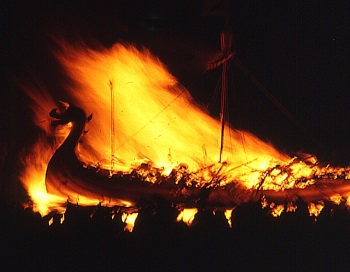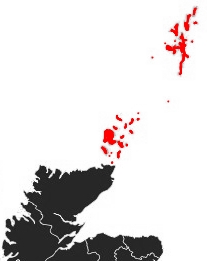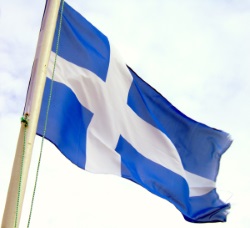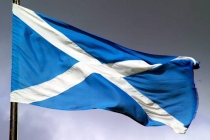Up Helly Aa 2015. A celebration of Shetland’s Viking Heritage

Shetland (Scottish Gaelic: Sealtainn), also called the Shetland Islands, lie to the north-east of Scotland. The islands are some 50 miles (80 km) to the northeast of Orkney and 170 miles (280 km) southeast of the Faroe Islands forming part of the division between the Atlantic Ocean to the west and the North Sea to the east. This is also where Scotland meets Scandinavia.
In 2000/2001 DNA sampling in Shetland and Orkney people were found to have a strong Viking genetic heritage with 60 per cent of the male population having DNA of Norwegian origin. The remainder of the area’s population was identified as similar to the Ancient Britons, with no evidence of Anglo-Saxon or Danish influences. It is also a place of great beauty where of the more than one hundred islands just 15 of them are inhabited; it is a noted haven for wildlife.
In Lerwick, the capital of Scotland's Shetland Islands, a fire festival named Up Helly Aa is held every January. Other smaller such festivals are also held on other parts of the Shetland Islands.

During Up Helly Aa, a procession of 1000 guizers celebrate their Norse heritage. There is a Guizer Jarl (Chief Guizer) who leads a Jarl Squad, which is one of the many Guizer squads participating in the event. Dressed in Viking clothing and marching through the town with battle axes and torches, they drag with them a ceremonial Viking longboat. Thousands of spectators line the route. At the end of the procession, the guizers throw their torches onto the longboat and set it alight. As the flames begin to subside, the traditional song "The Norseman's Home" is sung and night of celebration takes place. Words to the songs sang at Up Helly Aa can be found on the official website.

The Viking interventions began in the 8th century AD. The Islands of Scotland and the Isle of Man formed the Northern and Southern Isles. The Northern Isles of Shetland and Orkney were known to the Norse as Norðreyjar. The Southern Isles forming the Kingdom of Mann and the Isles (sometimes known as The Kingdom of the Isles) consisting of the Hebrides, the islands in the Firth of Clyde and the Isle of Man were known as Suðreyjar. In Suðreyjar there is clear history of the Norse settlers integrating with the native Gaelic population. Indeed the Vikings were assimilated by the Gaelic peoples, inter-married and eventually spoke their language. Chiefs of the Clans of the Western Isles point proudly to their Norse-Gael descent. In Norðreyjar there is also some archeological evidence indicating that the existing Picts who populated the islands of Shetland and Orkney were assimilated into the new Viking land. The DNA results showing 60% of the people being of Norwegian descent and the rest ancient Briton also gives some backing to this. There is no evidence of any battles between the peoples. Pictish items have been found in Viking settlements on the islands. It is also the case that given the proximity of Shetland and Orkney to Norway trading would have taken place long before Viking settlement. Examinations of a number of combs held at the Orkney Museum in Kirkwall revealed that some of the Pictish combs found in Birsay were actually made from reindeer antler as was the practice in Norway.

The Northern Isles (Norðreyjar) were subject to Viking invasions from the 8th Century and became a Viking stronghold. The Norwegian King Harald Hårfagre took control of the Islands in 875 AD and they became an earldom. They were ruled as a province of Norway and under the Jarl (Earl) during the Earldom of Orkney (rule also extended into parts of Caithness and Sutherland). King Christian I pledged the Islands as security for the dowry of his daughter Margaret of Norway who became Queen Margaret of Scotland (1469 to 1486) upon her marriage to James III of Scotland. The dowry not being paid the islands became part of the Kingdom of Scotland in 1471. Norwegian law was not abolished in Shetland until 1611 and the Norse based language of Norn continued in common use for over two centuries after that. Today, around 95% of Shetland’s place names have roots in the Old Norse Language.
It is the recognition and celebration of this Viking heritage that informs the ceremonies that take place during the festival of Up Helly Aa. It is an annual event that has become very significant in the Shetland calendar and is truly unique and exciting. Up Helly Aa takes place on Tuesday 27th January 2015. The timetable for the events is found on the official website.
Further reading
Celts and Vikings - Scandinavian Influences on the Celtic Nations
Manx Vikings, the great Irish-Celtic High King Brian Boru and the Battle of Clontarf
The Thing Sites: A Norse-Celtic trail
- Scottish
- English
- Log in to post comments





